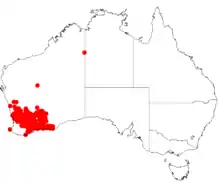Acacia lasiocalyx
Acacia lasiocalyx, commonly known as silver wattle[1] or shaggy wattle,[2] is a tree or shrub belonging to the genus Acacia and the subgenus Juliflorae.
| Shaggy wattle | |
|---|---|
| Scientific classification | |
| Kingdom: | Plantae |
| Clade: | Tracheophytes |
| Clade: | Angiosperms |
| Clade: | Eudicots |
| Clade: | Rosids |
| Order: | Fabales |
| Family: | Fabaceae |
| Clade: | Mimosoideae |
| Genus: | Acacia |
| Species: | A. lasiocalyx |
| Binomial name | |
| Acacia lasiocalyx | |
 | |
| Occurrence data from AVH | |
Taxonomy
The species is closely related to Acacia conniana which has nonpruinose branchlets, shorter phyllodes and smaller pods enclosing smaller seeds. Other relatives are A. anastema and A. longiphyllodinea.[3]
Description
The open often weeping tree or shrub typically grows to a height of 1.5 to 7 metres (5 to 23 ft),[1] although some specimens may reach 25 m.[5] It blooms from July to October producing yellow flowers. The leaf-like phyllodes are 25 centimetres (10 in) and gently curving,[1] each terminating in a hooked point. The inflorescences are simple, sometimes with a few rudimentary racemes interspersed with axes that are 0.5 to 1 millimetre (0.02 to 0.04 in) in length with paired peduncles paired that are 8 to 17 millimetres (0.3 to 0.7 in) long. They are pruinose with 20 to 40 millimetres (0.8 to 1.6 in) spikes and with a diameter of 6 to 7 millimetres (0.2 to 0.3 in) densely packed with a golden colour.[3] The seed pods are linear and raised over seeds with a straight to slightly curved shaped and are up to 16 centimetres (6.3 in) long and 5.5 millimetres (0.2 in) wide. The seeds are longitudinal with an elliptic to oblong shape.[3]
Distribution
It is native to a large area in the Wheatbelt, Goldfields-Esperance and Great Southern regions of Western Australia,[1] and is found as far north as Eneabba an south as Bremer Bay and east as Kalgoorlie.[3] It is typically found growing as a thicket amongst granite outcrops.[6]
Ecology
The tree is fibrous and copes well in arid conditions. It germinates prolifically after fire forming dense thickets of trees which are about 4 metres (13.1 ft) in height. These thickets thin out over the following decades, and trees my attain a height of 25 metres.[5]
See also
References
- "Acacia lasiocalyx". FloraBase. Western Australian Government Department of Parks and Wildlife.
- "Acacia Lasiocalyx (Shaggy Wattle Or Wilyurwur)". Westgrow Farm Trees. Retrieved 25 May 2017.
- "Acacia lasiocalyx C.R.P.Andrews, J. Western Australia Nat. Hist. Soc . 1: 41 (1904)". WorldWideWattle. CSIRO. 15 December 2016. Retrieved 25 May 2017.
- "Noongar names for plants". kippleonline.net. Archived from the original on 2016-11-20. Retrieved 20 November 2016.
- Stephen Hopper; Philippa Nikulinsky (2008). Life on the Rocks: The Art of Survival. Fremantle Press. ISBN 9781921361289.
- Margaret G. Corrick, Bruce Alexander Fuhrer (2009). Wildflowers of Southern Western Australia. Rosenburg Publishing. ISBN 9781877058844.